A great many players are troubled by the Battlefield 2042 unable to load persistence data error. If you are also trying to fix it, this post on MiniTool is worth reading. It summarizes 7 ways to fix the Battlefield 2042 game error.
Battlefield 2042 is a widely popular first-person shooter game released by EA on November 19, 2021. This game is now available on many platforms, including Microsoft Windows, PlayStation 4, PlayStation 5, Xbox One, and Xbox Series X/S.
Sometimes, however, the game can run into various error codes such as error code 2002g Battlefield 2042, Battlefield 2042 crashing, and the one discussed here. What causes the Battlefield 2042 unable to load persistence data error? How to fix it? Let’s keep reading.
Possible Causes of the Battlefield 2042 Unable to Load Persistence Data Error
According to user reports from the game community, the Battlefield 2042 game error often occurs when they’re trying to connect to EA’s online services. The actual reason for the error is still unknown, but many affected gamers find that problem is related to a poor network connection.
In addition, some other factors like game server status outage, corrupted game cache, Crossplay feature, improper DNS settings, and temporary glitches are also responsible for the “unable to load persistence data BF2042” error. Don’t worry. Here are several fixes to the error.
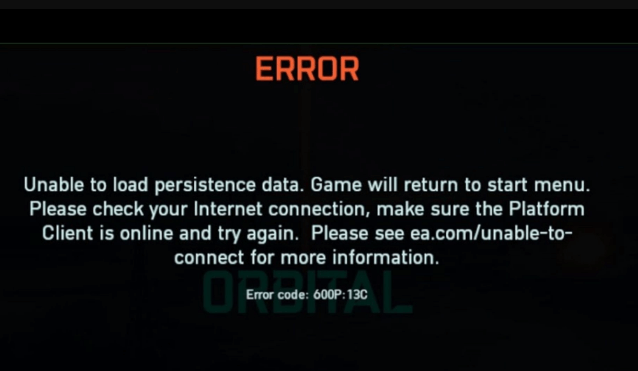
How to Fix the Battlefield 2042 Unable to Load Persistence Data Error
How to fix the “unable to load persistent data Battlefield 2042” error? We summarize 7 effective methods to fix the error on PC, PS4, and Xbox. Let’s start trying.
# 1. Simply Restart the Game and Your PC/Console
Sometimes the “BF2042 unable to load persistent data” error occurs just because of a temporary glitch. So, we recommend you restart the game and your PC/Console before trying any other advanced solutions.
To restart the game console, you can press and hold the Power button until the console is turned off completely. Then unplug the power cable from the console and wait for about 30 seconds, re-plug the power cable, and press the Power button to turn it on.
# 2. Check Your Internet Connection
An unstable network connection can trigger the “Battlefield 2042 unable to load persistent data PC” error as well. In this case, you can try restarting your router and see if it works.
Step 1. Unplug the internet router from the wall socket.
Step 2. Hold the Power button on the back of your router for about 15 seconds until the router is turned off completely.
Step 3. Then wait for at least 30 seconds, re-plug the router into the socket and press the Power button to restart it.
If the BF 2042 persistence data error persists, you can use a wired connection or contact your ISP to optimize the network connection.
# 3. Check the Game Server Status
We also recommend you check the Battlefield 2042 servers‘ status. If the servers are down due to maintenance, you may experience the “unable to load persistence data BF2042” error. In this case, all things you need to do is wait for the servers to be up. If not, you can continue the following fixes.
# 4. Clear the Download Cache (PC Only)
Some players reported that the “Battlefield 2042 unable to load persistent data PC” error can be solved by clearing the download cache in Steam. Here you may have a try.
Step 1. Open your Steam client, and then navigate to the Steam tab in the upper left corner.
Step 2. Then go to Settings > Downloads from the left action panel.
Step 3. Click on the CLEAR DOWNLOAD CACHE button from the right panel, click on OK to confirm it, and then wait for the processes to complete.
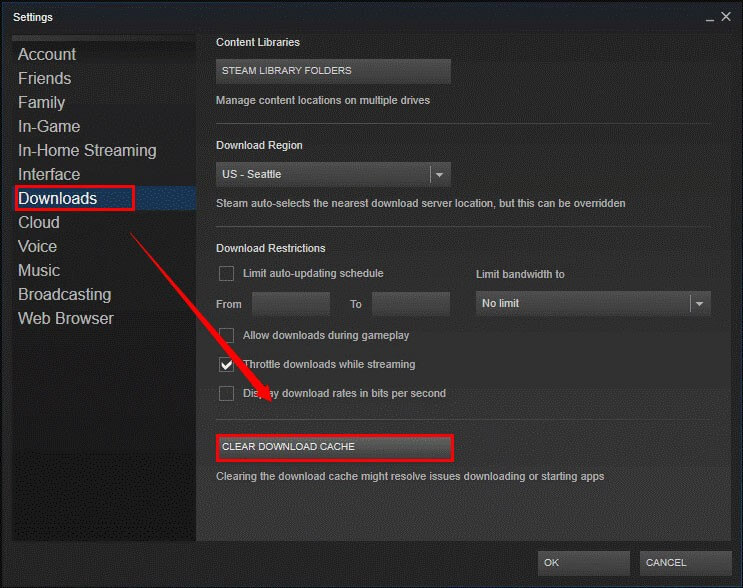
Now, you can restart the game on your PC and check if the “unable to load persistent data Battlefield 2042” error gets fixed.
# 5. Disable Crossplay (PC/Xbox)
Some other gamers reported that disabling the Crossplay feature can get rid of the “BF 2042 unable to load persistent data” error. Here’s how to disable it on PC/ Xbox.
Disable Crossplay for PC:
- Launch Battlefield 2042 to enter its main menu and click on Options at the bottom left corner of the screen and select General.
- Go to the Other section and turn off the Crossplay
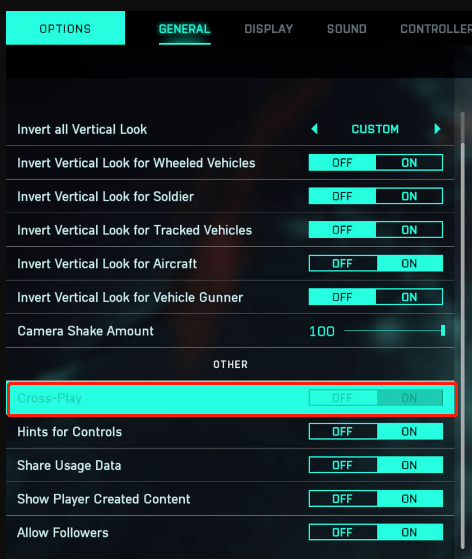
Disable Crossplay for Xbox:
- Press the Xbox button on your controller to open the Guide
- Go to the Settings tab and select General > Online Safety & Family.
- Go to the Privacy and Online Safety section and select Xbox privacy.
- Select View Details and Customize > Communication and Multiplayer.
- Now, select Block under the You can join cross-network play
# 6. Switch to a Different DNS Server (PC/PS4/Xbox)
Sometimes inconsistent DNS range is also responsible for the Battlefield 2042 game error. To fix the problem, you can try switching to a more stable DNS server like Google DNS. Here’s how to change DNS on PC/PS4/Xbox.
Change DNS on PC:
Step 1. Open your Control Panel from the Start menu.
Step 2. Change the View by type to Category, and then navigate to Network and Internet > Network and Sharing Centre > Change adapter settings.
Step 3. Right-click the active network and select Properties.
Step 4. Navigate to the Networking tab, and then select Internet Protocol Version 4 (TCP/IPv4) and click on Properties.
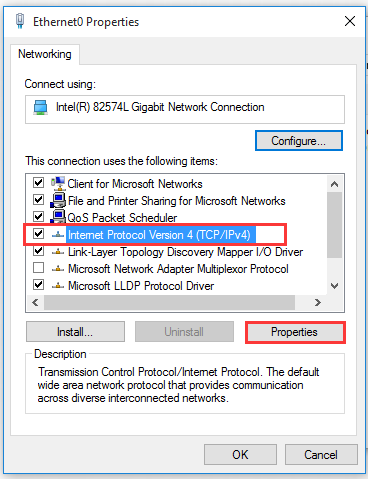
Step 5. Select the Use the following DNS server addresses option, and then set the Preferred DNS server to 8.8.8.8 and Alternative DNS server to 8.8.4.4. After that, click on OK to save the changes.
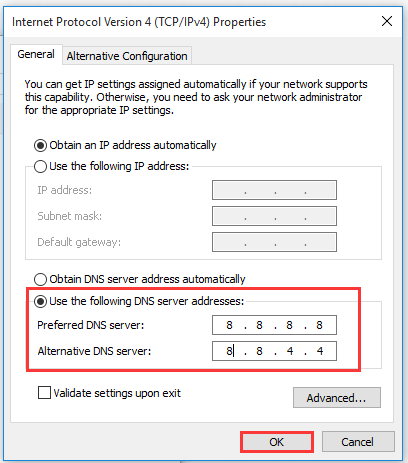
Change DNS on PS4:
Step 1. Open the Setting menu from the PS4 dashboard, and then navigate to Network > View Connection Status.
Step 2. Note down the numbers next to IP Address, Subnet Mask, and Default Gateway.
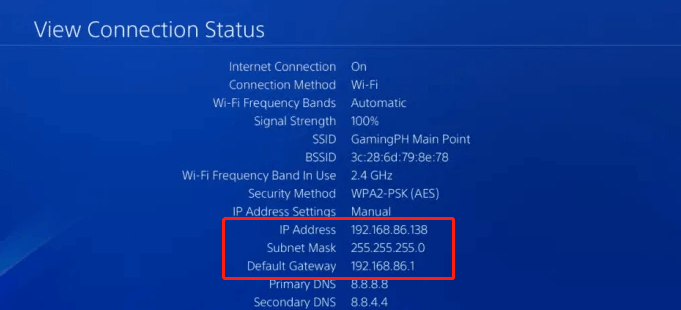
Step 3. Navigate back to the Network settings window and select Set Up Internet Connection. Then select your connection and you will be prompted to set up your Internet connection.
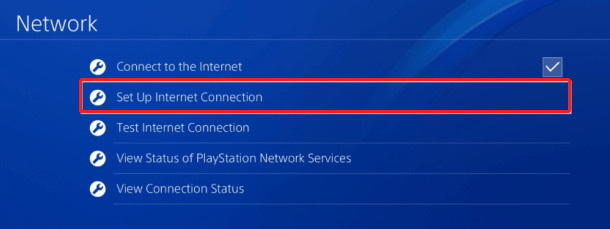
Step 4. In the new window, select Custom > IP Address Settings > Manual.
Step 5. Now you can enter the IP Address, Subnet Mask, and the Default Gateway information you noted down in Step 2. And then set Primary DNS: 8.8.8.8 and Secondary DNS: 8.8.4.4 and click on Next to continue.
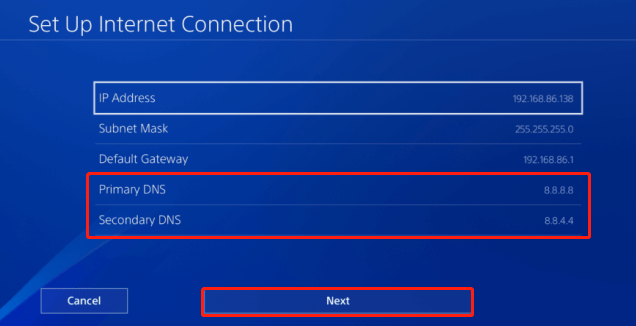
–image from the gameinpost
Change DNS on PS4:
Step 1. Press the Xbox button on your Xbox controller to open the Home screen and select the Settings
Step 2. Open All Settings and select Network.
Step 3. Navigate to the Advanced Settings tab and select DNS Settings.
Step 4. Select Manual from the drop-down menu, and then set the Primary DNS value to 8.8.8.8 and Secondary DNS to 8.8.4.4.
Step 5. Save the changes and click on Continue to check if the DNS server works well.
# 7. Forward the Required Ports for the Game (PC/PS4/Xbox)
If you are using an older router model that doesn’t support UPnP, the required ports may fail to open for the game and trigger the “unable to load persistence data BF2042” error. In this case, you can follow the guide below to manually forward the required ports to the game.
Step 1. Open your web browser, and then type the router’s IP address in the address bar and hit Enter. (If you don’t know how to find your IP address, this guide can help you.)
Step 2. On the login page, type your username and password. Then click on the Login button to open the router page.
Step 3. Inside the router settings, go to the Advanced menu and select NAT Forwarding or Port Forwarding from the left pane.
Step 4. Select the Virtual Servers option from the right pane and then you can see if there is a button named Add that allows you to add additional ports. If it is, click on Add.
Step 5. Add the ports that you need to forward for BF2042. Bear in mind that the ports are different depending on the platform (PS4, Xbox One, and PC). Here we list them as follows:
PC:
TCP: 5222, 9988, 17502, 20000-20100, 22990, 42127
UDP: 3659, 14000-14016, 22990-23006, 25200-25300
PS4/PS5:
TCP: 1935, 3478-3480
UDP: 3074, 3478-3479, 3659, 14000-14016
Xbox One and Xbox Series X|S:
TCP: 3074
UDP: 88, 500, 3074, 3544, 4500
Step 6. Once done, restart both your router and console/PC and see if the “BF2042 unable to load persistent data” error disappears.
Further reading: If you enter some issues like file system corruption and low disk space on Windows 10/11, don’t worry. MiniTool Partition Wizard can help you fix them easily by checking file system errors, extending/resizing partitions, analyzing disk space, upgrading to a larger hard disk, etc.


User Comments :